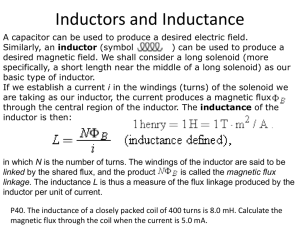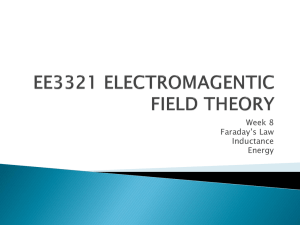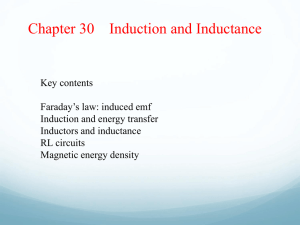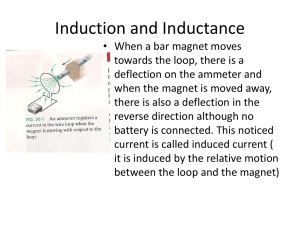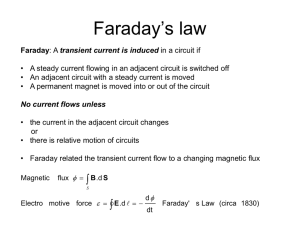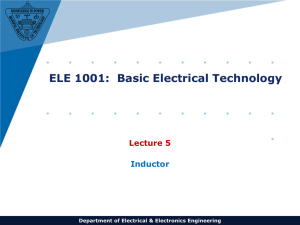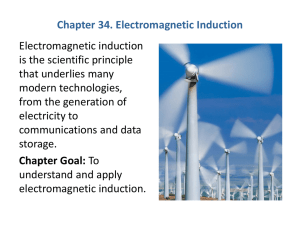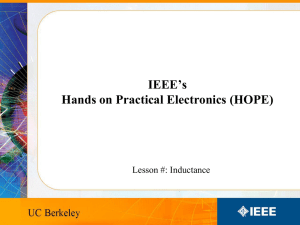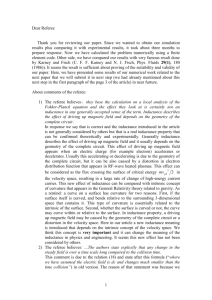Lecture 15 - UCF Physics
advertisement
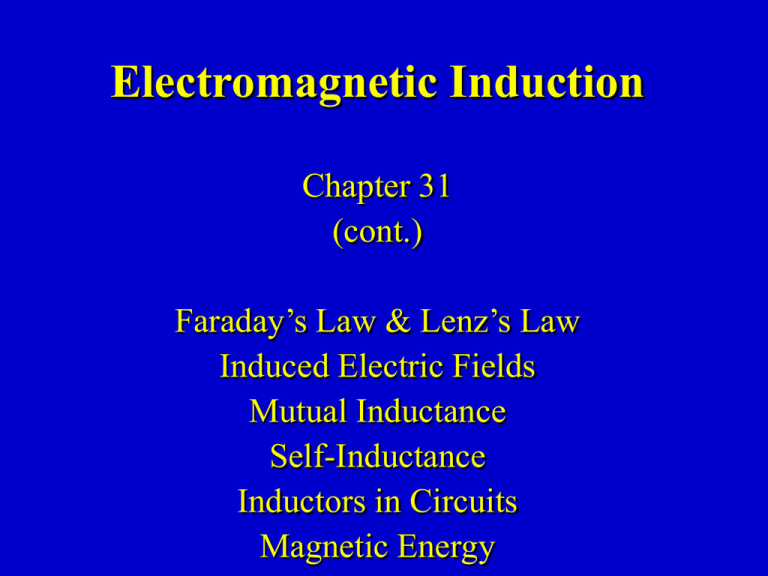
Electromagnetic Induction
Chapter 31
(cont.)
Faraday’s Law & Lenz’s Law
Induced Electric Fields
Mutual Inductance
Self-Inductance
Inductors in Circuits
Magnetic Energy
Electromagnetic Induction
Faraday’s Law
A changing magnetic field induces an emf
proportional to the rate of change of magnetic flux:
e = - dB / dt
The emf is about some loop – and the flux is through that loop.
B
B dA Bcos dA
Lenz’s law: the induced emf is directed so that any induced
current opposes the change in magnetic flux that causes the
induced emf.
Rotating Loop - The Electric Generator
Consider a loop of area A in a
uniform magnetic field B.
Rotate the loop with an angular
frequency w.
The flux changes because angle
changes with time: = wt.
Hence
dB/dt = d(B · A)/dt
= d(BA cos )/dt
= BA d(cos(wt))/dt
= - BAwsin(wt)
B
A
A
Rotating Loop - The Electric Generator
B
A
dB/dt = - BAwsin(wt)
• Then by Faraday’s Law this motion causes an emf
e = - dB /dt =
BAwsin(wt)
• This is an AC (alternating current) generator.
Induced Electric Fields
Consider a stationary wire
in a time-varying magnetic field.
A current starts to flow.
x dB/dt
So the electrons must feel a force F.
It is not F = qvxB, because the charges started stationary.
Instead it must be the force F=qE due to an
induced electric field E.
That is:
A time-varying magnetic field B
causes an electric field E to appear!
Induced Electric Fields
Consider a stationary wire
in a time-varying magnetic field.
A current starts to flow.
x dB/dt
So the electrons must feel a force F.
It is not F = qvxB, because the charges started stationary.
Instead it must be the force F=qE due to an
induced electric field E.
Moreover E around the loop gives a voltage diff DV=E·dl.
And this must be the emf:
e = o E·dl
Induced Electric Fields
This gives another way to write Faraday’s Law:
o E·dl = - dB/dt
A technical detail:
The electrostatic field E is conservative: o E·dl = 0.
Consequently we can write E = - V.
The induced electric field E is NOT a conservative field.
We can NOT write E = -V for an induced field.
Electrostatic Field
Induced Electric Field
F=qE
F=qE
DVab = - E·dl
o E·dl
= 0 and Ee = V
Conservative
Work or energy difference
does NOT depend on path
Caused by stationary
charges
o
E · dl = dB/dt
o E·dl 0
Nonconservative
Work or energy difference
DOES depend on path
Caused by changing
magnetic fields
Induced Electric Fields
E · dl = - dB/dt
o
x
B
Faraday’s Law
Now suppose there is no conductor:
Is there still an electric field?
YES! The field does not depend
on the presence of the conductor.
For a dB/dt with axial or cylindrical
symmetry, the field lines of E are circles.
E
dB/dt
Mutual Inductance
• Two coils, 1 & 2, are arranged such that flux
from one passes through the other.
• We already know that changing the current in 1
changes the flux (in the other) and so induces
an emf in 2.
• This is known as mutual inductance.
Bof 1 through 2
I
1
2
Mutual Inductance
Bof 1 through 2
I
1
2
The mutual inductance M is the proportionality constant
between 2 and I1:
2 = M I1
so d2 /dt = M dI1 /dt
Then by Faraday’s law:
e2= - d2 /dt = - M dI1 /dt
Hence M is also the proportionality constant
between e and dI /dt.
Mutual Inductance
• M arises from the way flux from one coil passes
through the other: that is from the geometry and
arrangement of the coils.
• Mutual means mutual. Note there is no subscript
on M: the effect of 2 on 1 is identical to the effect
of 1 on 2.
• The unit of inductance is the Henry (H).
1 H = 1Weber/Amp = 1 V-s/A
Self Inductance
A changing current in a
coil can induce an emf
in itself….
I
B
• If the current is steady, the coil acts like an ordinary piece
of wire.
• But if the current changes, B changes and so then does B,
and Faraday tells us there will be an induced emf.
• Lenz’s law tells us that the induced emf must be in such a
direction as to produce a current which makes a magnetic
field opposing the change.
Self Inductance
• The self inductance of a circuit element (a coil, wire,
resistor or whatever) is L = B/I.
• Then exactly as with mutual inductance e = - L dI/dt.
• Since this emf opposes changes in the current (in the
component) it is often called the “back emf”.
• From now on “inductance” means self-inductance.
Example: Finding Inductance
What is the (self) inductance of a solenoid with area A,
length d, and n turns per unit length?
In the solenoid B = m0nI, so the flux through one turn
is fB = BA = m0nIA
The total flux in the solenoid is (nd)fB
Therefore, B = m0n2IAd and so L = B/I gives
L = m0n2Ad
(only geometry)
Inductance Affects Circuits
and Stores Energy
• This has important implications…..
• First an observation: Since e cannot be
infinite neither can dI/dt. Therefore, current
cannot change instantaneously.
• We will see that inductance in a circuit
affects current in somewhat the same way
that capacitance in a circuit affects voltage.
• A ‘thing’ (a component) with inductance in a
circuit is called an inductor.
RL Circuit
We start with a simple circuit containing a battery, a switch, a resistor,
and an inductor, and follow what happens when the switch is closed.
S
e0 +-
R
L
While the switch is open current
can’t flow.
RL Circuit
We start with a simple circuit containing a battery, a switch, a resistor,
and an inductor, and follow what happens when the switch is closed.
R
S
e0 +-
L
S
+
e0 -
I
While the switch is open current
can’t flow.
When the switch is closed current I
flows, growing gradually, and a ‘back
eL emf’ eL=- L dI/dt is generated in the
inductor. This opposes the current I.
RL Circuit
We start with a simple circuit containing a battery, a switch, a resistor,
and an inductor, and follow what happens when the switch is closed.
R
S
e0 +-
L
When the switch is closed current I
flows, growing gradually, and a ‘back
S
+
e0 -
I
While the switch is open current
can’t flow.
eL emf’ eL=- L dI/dt is generated in the
inductor. This opposes the current I.
S
e0 +-
Is
0
After a long time the current
becomes steady. Then eL is zero.
RL Circuit
When the switch S is closed
S
e0 +-
I
the current I increases exponentially from I = 0 to I = e0/R
e /R
0
I
0
0
1
2
3
t/(L/R)
4
5
RL Circuit Analysis
+
e0 -
Use the loop method
R
S
I
L
e0 - IR - LdI/dt = 0
LdI/dt = e0 - IR = -R[I-(e0 /R)]
dI / [I-(e0 /R)] = - (R/L) dt dI / (I-(e0 /R)) = - (L/R) dt
ln[I-(e0 /R)] – ln[-(e0 /R)] = - t / (L/R) ln[-I/(e0 /R) + 1] = - t / (L/R)
-I/(e0 /R) + 1 = exp (- t / (L/R)) I/(e0 /R) = 1 - exp (- t / (L/R))
I = (e0 /R) [1 - exp (- t / (L/R))]
RC Circuit Analysis
R
S
+
e0 -
I
I = (e0/R) [1 - exp (- t / (L/R))]
L
The current increases
exponentially
with time constant
=L/R
e0 /R
I
0
0
1
2
3
t/(L/R)
4
5
t=0I=0
t = I = e0 /R
Inductor’s emf eL
+
e0 -
eL = - L (dI/dt)
R
S
I
I = (e0/R) [1 - exp (- t / (L/R))]
L
eL = L (e0/R) (-R/L) exp (- t / (L/R))
eL = - e0 exp (- t / (L/R))
0
eL
t = 0 eL = - e0
-e0
0
1
2
3
t/(L/R)
4
5
t = eL = 0
Decay of an RL Circuit
S
R
+
e0 -
L
• After I reaches e0/R move the switch as shown.
• The loop method gives
eL - IR = 0 or eL = IR
• Remember that eL = -L dI/dt -L dI/dt = IR
dI/I = - dt / (L/R) dI/I = - dt / (L/R)
• ln I/I0 = - t / (L/R) I = I0 exp [- t / (L/R)]
• But I0 = e0/R
• Then: I = (e0/R) exp [- t / (L/R)]
Inductors in Circuits
• The presence of inductance prevents currents
from changing instantaneously.
• The time constant of an RL circuit is = L/R.
• When the current is not flowing the inductor
tries to keep it from flowing. When the current
is flowing the inductor tries to keep it going.
Energy Stored in an Inductor
R
S
e0 +-
I
L
Recall the original circuit when current was changing
(building up). The loop method gave: e0 - IR + eL = 0
Multiply by I and use eL = - L dI/dt
Then:
Ie0 - I2R - ILdI/dt = 0
or:
Ie0 - I2R – d[(1/2)LI2]/dt = 0
{d[(1/2)LI2]/dt=ILdI/dt}
• Think about Ie0 - I2R - d((1/2)LI2)/dt = 0
• Ie0 is the power (energy per unit time) delivered by the
battery.
• I2R is the power dissipated in the resistor.
• Think about Ie0 - I2R - d((1/2)LI2)/dt = 0
• Ie0 is the power (energy per unit time) delivered by the
battery.
• I2R is the power dissipated in the resistor.
• Hence we’d like to interpret d((1/2)LI2)/dt as the rate at
which energy is stored in the inductor.
In creating the magnetic field in the inductor
we are storing energy
• Think about Ie0 - I2R - d((1/2)LI2)/dt = 0
• Ie0 is the power (energy per unit time) delivered by the
battery.
• I2R is the power dissipated in the resistor.
• Hence, we’d like to interpret d[(1/2)LI2]/dt as the rate
at which energy is stored in the inductor.
In creating the magnetic field in the inductor
we are storing energy
• The amount of energy in the magnetic field is:
UB = (1/2) LI2
Energy Density in a Magnetic Field
• We have shown U B LI 2
2
• Apply this to a solenoid:
1
A
A 2
2 2 2
U B mo n A I
mo n I
B
2
2mo
2mo
by the volume of the solenoid, the stored energy
Dividing
1
•
2
2
density is:
uB = B2/(2m0)
• This turns out to be the
energy density in a magnetic field
Summary
•
•
•
•
•
We defined mutual and self inductance,
Calculated the inductance of a solenoid.
Saw the effect of inductance in RL circuits.
Developed an expression for the stored energy.
Derived an expression for the energy density of a
magnetic field.
• Next class we will start learning about alternatingcurrent (AC) circuits, containing resistors, capacitors,
and inductors.
